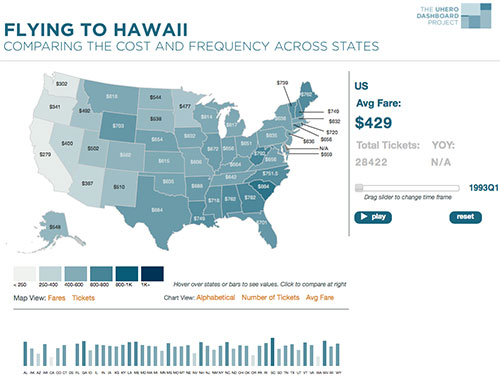By James Jones and Peter Fuleky
The latest installment in the UHERO dashboard project is packed with information on the cost of travel to Hawaii from the US mainland. The visitor industry is one of Hawaii’s largest, and more than 60% of all visitors to the state come from the US mainland. In this dashboard we look at how airfare and arrival patterns to Hawaii have changed over the past 20 years.
The data for this dashboard comes from the Airline Origin and Destination Survey administered by the US Bureau of Transportation Statistics. The survey gathers information on airfare, itinerary, and number of passengers from a sample of roughly 10% of all airline tickets sold by domestic carriers. Data is collected each quarter in a large database that we query for Hawaii specific information.
The detailed sample allows us to analyze fluctuations over time and across states. We count the number of passengers that booked round trip tickets to Hawaii from each state for each quarter from 1993 through the second quarter of 2014 (the most recent data available). From the prices of round-trip tickets, we calculate the median airfare for each state. For some smaller states airfares can be quite volatile from one quarter to the next due to the tiny sample size and the mix of first class, business class, and coach fares, as well as discounted and promotional fares. We also calculate an average US fare by taking a weighted average of each state’s median airfare.

Turning to the visualization, the differences in airfare and visitor volume from state to state are fairly intuitive. For the most part, tickets from the West Coast are cheaper than tickets from the East Coast. And visitor volumes from more populous states like California and Texas are higher than less populous states like Wyoming and Vermont. One interesting fact is that seasonal fluctuations in visitor volume vary significantly from state to state. For example visitor arrivals from Minnesota follow a very strong seasonal pattern, whereas visitor arrivals from Arizona does not exhibit much seasonality.
Increases in airfares in recent years may help to explain why US arrivals to the state still haven’t recovered to pre-recession levels. Between the fourth quarter of 2006 (the peak quarter for US visitor arrivals) and the second quarter of 2014, the US average airfare to Hawaii has increased by more than 50%. In addition, hotel room rates in Hawaii have increased by almost 25% during the same period. Such increases in the cost of a trip have pushed a Hawaii vacation out of reach for many would-be visitors, especially given the lackluster gains in US household income over the past decade.
BLOG POSTS ARE PRELIMINARY MATERIALS CIRCULATED TO STIMULATE DISCUSSION AND CRITICAL COMMENT. THE VIEWS EXPRESSED ARE THOSE OF THE INDIVIDUAL AUTHORS. WHILE BLOG POSTS BENEFIT FROM ACTIVE UHERO DISCUSSION, THEY HAVE NOT UNDERGONE FORMAL ACADEMIC PEER REVIEW.